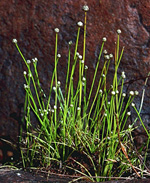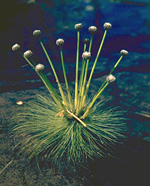 |
This distinctive family is pantropical and subtropical with a centre of diversity in tropical America. In Australia it comprises a single genus, Eriocaulon, members of which are found in wetlands or marshy habitats. They are small and often inconspicuous, and distributed from eastern Victoria around the east coast and across the tropical north and the northern part of the arid zone. No species occur in the south-west, across most of southern Australia, or in Tasmania.
Characteristic features of the family Eriocaulaceae in Australia include: - small herbs with linear, tufted leaves
- flowers small, in dense, whitish heads surrounded by dark bracts, borne on the ends of erect, often rather stiff, unbranched scapes
- flowers minute, unisexual, surrounded by two whorls of fringed perianth scales
- ovary superior with a single apical ovule; fruit a small capsule
Description
Annual or perennial terrestrial herbs, or aquatic herbs rooted in the substrate with their leaves submerged or floating. Perennating by rhizomes. Vegetative reproduction absent or by ?bulbils. Internal secretions not obvious. Plants glabrous or with simple, non-glandular, uniseriate hairs. Leaves alternate and spiral, both basal and cauline, sessile. Stipule-like lobes absent. Lamina simple, symmetric, filiform, acicular, subulate or linear; base lobed or auriculate; margins entire, ±flat; venation parallel, with the midrib inconspicuous, and the tertiary venation reticulate; surfaces not punctate; herbaceous. Leaf ligule absent. Male and female flowers occurring on the same plant, or rarely bisexual and male flowers occurring together. Inflorescences terminal, consisting of capitula. Spathes present. Bracts present. Pollination by insects or wind. Flowers odourless; sessile. Floral disc absent; nectaries present on the perianth. Perianth of 2 dissimilar whorls, of 1 whorl only, or all whorls ±similar, or vestigial, or absent, with (2–) 6 segments. Calyx regular or irregular; segments (1–) 2–3, free (sepals) and spathulate, or fused (lobes) and tubular, ?valvate in bud, papery. Corolla regular; segments free or fused, (1–) 2–3, alternating with the sepals or calyx lobes; corolla bell-shaped, funnel-shaped or tubular, 1-lipped, white, grey, brown or black, without contrasting markings, membranous; claws present or absent; lobes ±entire or notched, emarginate, bifid or bilobed. Fertile stamens 2, 4 or 6, opposite to, or both opposite and alternating with the sepals or calyx lobes, free of the corolla, free of the ovary and style, distinct from each other, all ±equal or 2 unequal pairs. Anthers dorsifixed or basifixed, versatile, opening inwards by longitudinal slits, 2-celled. Ovary superior and sessile. Carpels 2–3, fused; ovary with 2–3 locules. Style terminal, single and branched above. Ovules 1 per locule, sessile; placentation apical. Fruit a dry, dehiscent loculicidal capsule; the perianth on the maturing fruit deciduous. Disseminule macro-surface featureless or winged; micro-surface ±smooth, orange or brown, glossy or dull. Seeds 2 or 3 per fruit. Aril absent. Cotyledons 1. Embryo lens-shaped.
(Note: this description has been generated from the coded data compiled for the key. Any errors in the key data will be reflected in the descriptions.)
A treatment of the family Eriocaulaceae has not yet been published in the Flora of Australia. It will appear in Volume 40.
Australian genera of Eriocaulaceae (as recognised for the Flora of Australia)
Eriocaulon

|
  |

Eriocaulon (flowering plant)
Photo: S.Jacobs © S.Jacobs

Eriocaulon setaceum (flowering plant)
Photo: A.S.George © A.S.George
|

| |